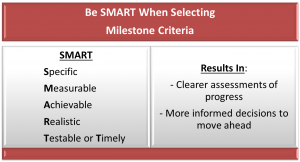 Your agency just received a legislative mandate to implement a capability by a specific date. The mission could range from expanding a capability, to improving security at a checkpoint, to meeting an estimated surge in demand for transactions in a compressed time period. It may take months or years to accomplish the mission.
Your agency just received a legislative mandate to implement a capability by a specific date. The mission could range from expanding a capability, to improving security at a checkpoint, to meeting an estimated surge in demand for transactions in a compressed time period. It may take months or years to accomplish the mission.
You may be looking down the road to the final outcome, but you’ll have a much tougher time getting there if you don’t build in a series of milestones along the way. I recommend five ways to achieve a successful milestone decision, but first a reminder on why they’re so important.
Why Milestone Decisions Matter
Many federal agencies have acquisition management roadmaps or decision-support processes that forge knowledge into action through logically structured stages and gates. The gates or significant events are often called milestones and require certain criteria to be met before making the decision to complete a previous stage, and proceed to the  next stage of the process. For example, moving to award a development contract based on results from the previous phase where the most cost-effective and aligned solution was selected; or a program requesting approval to field a solution after completing successful live or operational testing. I recommend using the SMART approach when selecting milestone criteria (see sidebar).
next stage of the process. For example, moving to award a development contract based on results from the previous phase where the most cost-effective and aligned solution was selected; or a program requesting approval to field a solution after completing successful live or operational testing. I recommend using the SMART approach when selecting milestone criteria (see sidebar).
The milestones offer an opportunity for implementation teams to demonstrate knowledge and progress to date to formal review boards. These bodies are typically comprised of key stakeholders, such as end users, and oversight groups. With missions and budgets at stake, these milestones can show how the program is managing risk. For example, the program could present outputs of its risk management plan that shows a thorough treatment of risk identification, assessment, analysis, and mitigation. Further, at a milestone review, a program could communicate a change in acquisition strategy based on lessons learned from the results of a previous phase or project.
Take milestone decisions seriously. A successful milestone demonstrates the program is gleaning knowledge and making progress in doing the right things to meet mission. This can help defend existing resources, or if needed, garner new ones. Also, achieving a successful milestone decision on the first pass can help you avoid the kind of delays and rework that increase cost and jeopardize mission.
How to Achieve a Successful Milestone Decision
When a mission requires relatively large acquisitions, complexity can arise with so many requirements, activities, and interrelationships. This complexity drives risk which jeopardizes a successful first pass through the gate. How do you mitigate this? Based on my experience, I’ve found these five guidelines to be useful:
- Start with the team: Select a mix of people whose skills and acquisition experience are complimentary. Having prior experience working with each other on a previous milestone is a plus. People credentialed in related disciplines such as program management, contracting, cost estimating, testing, and logistics bring depth of expertise. However, it’s also critical to have people who have actual experience leading and supporting teams that have achieved successful milestone decisions. Finally people who possess intangibles such as accountability (e.g., to customers, stakeholders, teammates), initiative, and professionalism can boost your odds of success.
- Understand the criteria: The team should be able to understand clear and complex criteria for achieving a successful milestone decision. For example, specific criteria may contain questions in which the answers are laid out in documents such as a business case and acquisition strategy. The answers meet the criteria by being coherent, compliant, and well-thought out.
- Plan the work and work the plan: After identifying and understanding required criteria for a successful milestone decision, the next step is to lay out a plan of action and interim milestones that contain inputs, activities, outputs, and outcomes needed to satisfy the criteria. This information should be part of your master schedule as well as the resources you will need to execute the plan and schedule. Consider using a tool for your team to collaborate and share knowledge during the effort.
- Assess and communicate progress against plan: Assess frequently how you are doing against your plan. For example, is the document ready for final presentation to the milestone decision review board? Do you need to perform additional quality checks to ensure the documents are consistent and coherent? Do you have enough information for the review board to make an informed decision? Communicate progress against your plan to stakeholders often, to minimize surprises at the end.
- Lessons Learned / Continuous Improvement: Convene the team and identify what worked and what could be improved. Apply a laser focus on identifying and testing ways to improve processes. Keep a lessons learned archive and track how well you are implementing your lessons learned on future efforts.
Remember, mission success is often met through a series of successful milestones, or significant events, taking months and even years. Therefore to make a significant event successful, ensure you invest in a significant team that prioritizes success in the short and long term.

